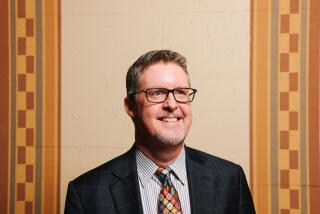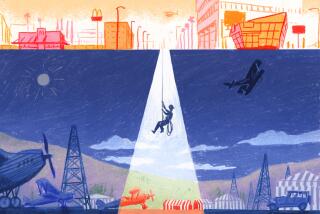Paperback Writers: Sunlight and shadow in ‘Los Angeles in the 1930s’
Created by FDR in 1935, in the depths of the Great Depression, the Federal Writers’ Project (a small part of the wider Works Progress Administration) was a make-work agency that gave jobs to about 6,500 writers, editors and researchers before closing shop in 1943. The government, in other words, used taxpayers’ money to pay small but welcome salaries to writers. Go figure.
“A triumphant gesture and so noble as to be almost absurd,” said poet W.H. Auden (not a beneficiary), and one imagines the swirl of teapot tempests that an attempt to repeat such a quixotic project would induce today. Yet the writers’ project played its part in the careers of Saul Bellow, Nelson Algren, Ralph Ellison, Tillie Olsen, Richard Wright and Jim Thompson, among many others, and left behind a series of beautiful publications, notably the 81 guides that covered each state and many of the major cities.
“Los Angeles: A Guide to the City and Its Environs” has been reissued as “Los Angeles in the 1930s: The WPA Guide to the City of Angels” in an exact reproduction of the original text, with a nimble and witty introduction by David Kipen and a new jacket featuring a glowing pastoral of downtown’s Union Stationa new building at the time of the guide’s first publication in 1941.
Is this book, as Kipen suggests, “a treasure dragged back from some lost dreamland”? Or a key reference point in the history of writing about Los Angeles, a city whose literary self-consciousness almost from the start involved the myth of an Eden that was supposedly lost?
“Los Angeles,” like all the other guides in the WPA series,, including “San Francisco in the 1930s: The WPA Guide to the City By the Bay” (for which Kipen also provides an introduction), was packaged for use. It begins with pages of facts, lists of general information, descriptions of hotels and nightclubs: “As in all large cities, the quality of Los Angeles after-dark entertainment varies. There is the honky-tonk area of Main Street and East Fifth Street, where semi-nude ‘B-girls’ have brought Los Angeles nationwide notoriety by way of national magazine articles.”
Semi-nude “B-girls”! Welcome to Sin City, baby! Those “national magazine articles,” splashed throughout the late 1930s in Time, Newsweek, Collier’s, Liberty, Life and the Saturday Evening Post, zeroed in on not just the glitz and sex of Hollywood, but the octopus of gangsterism and civic turpitude then entangling City Hall. This had been a time when, under the mayorship of Frank Shaw, LAPD captaincies were bought for $500 by those who knew the greasable palms.
“For many decades the city has suffered from journalistic superficiality; it has been lashed as a city of sin and cranks; it has also been strangled beneath a blanket of unrestrained eulogy,” writes John D. Keyes, state supervisor of the Southern California Writers’ Project, in his preface to the guide, fingering the noir-booster dialectic so much at the heart, even then, of writing about the city.
Many of the guide’s anonymous observations (no individual contributors have their names attached) ring out with the sharpness of aphorisms that still seem spot on: “Water — both fresh and salt — has been a vital factor in Los Angeles’ destiny”; “The city of Los Angeles has great expanse but little height”; “Los Angeles is architecturally flamboyant, and even discordant.”
Others beautifully situate the reader at a lost moment in time. Here is moviemaking, circa 1910: “The respectable and God-fearing were shocked and were themselves soon dancing with rage at seeing baggy-trousered comedians prancing up and down the streets; cowboys paraded the town on their skittish broncos, to the terror and delight of small boys and the fuming exasperation of their elders.…”
The guide feels less politicized than the Los Angeles sections in “California: A Guide to the Golden State” published two years earlier in 1939. The story of the building of the Los Angeles aqueduct, for instance, glides past the land theft that accompanied it and the troublesome issue of the subsequent war waged by the farmers of the Owens River Valley. And the downtown tour entry for the Los Angeles Times building notes: “Atop the clock tower is the bronze eagle that survived the dynamiting of the old Times plant in 1910 (see The Historical Background).” Yet, in that earlier section laying out that history, there’s no mention of the bombing. Presumably that bit was removed at some point, and editors forgot to tweak the later reference, leaving that hole like a gap tooth.
The guides were controversial all over the country, of course. Some politicians, even Democrats, thought the writers’ project was a Communist plot. And as it’s revealed on the title page, “Los Angeles” was co-sponsored by the Los Angeles County Board of Supervisors, maybe we should be grateful that what we got is as good as it is. The guide remains addictively readable and features, as Kipen notes, sheaves of “dazzling monochrome photography” from the likes Julius Shulman and Fred William Carter. It’s still alive and has become big history in the debate it set out to report, the one that asks the questions: What exactly is L.A., and whither goes it?
Rayner is the author, most recently, of “A Bright and Guilty Place: Murder, Corruption, and L.A.’s Scandalous Coming of Age.”
More to Read
Sign up for our Book Club newsletter
Get the latest news, events and more from the Los Angeles Times Book Club, and help us get L.A. reading and talking.
You may occasionally receive promotional content from the Los Angeles Times.






